Subjective Assignment
BOARD LEVEL QUESTIONS ON BASICS OF CIRCUITTHEORY, SERIES AND PARALLEL COMBINATIONS
Q.1
Given n resistors each of resistance B. how will you combine them to get the
(i) maximum, and
(ii) minimum effective resistance? What is the ratio of the maximum to minimum resistance?
Ans : (i) In Series, (ii) In Parallel. , n2
Q.2
A cell of emf 2 volts is connected to three resistance in series of 2 \displaystyle \Omega , 3 \displaystyle \Omega , and 4 \displaystyle \Omega . Find the potential difference across 3 \displaystyle \Omega resistance.
Ans: 2/3 volt
Q.3
Two resistance are joined in parallel and give resultant of 6/5 \displaystyle \Omega . Now one of the resistance is broken and the effective resistance becomes 2 \displaystyle \Omega . Find the resistance of the broken wire.
Ans : 3 W
Q.4
A battery of emf 1.4volt and internal resistance 2 \displaystyle \Omega is connected to resistance of 100 \displaystyle \Omega through an ammeter. The resistance of the ammeter is 4/3 \displaystyle \Omega . A voltmeter has been connected to find the potential difference across the resistor.
(a) Draw the circuit diagram.
(b) The ammeter reads 0.02A.What is the resistance of voltmeter ?
(c) The voltmeter reads 1.1volt.What is the error in the reading ?
Ans : (b) 200W ,(c) 0.2volt
Q.5
A battery of emf 5volts,10W is connected to a combination of 50W and 40W in series. A voltmeter of resistance of 1000W is connected across 40.Find the percentage error in the reading of the voltmeter and the current drawn from the battery.
Ans : 25%
Q.6
When n identical resistance are connected in series their net resistance is x. Find the net resistance if all these resistance are connected in parallel.
Ans : x/n2 .
7.
Find the reading of the ammeter and voltmeter in the following circuit.
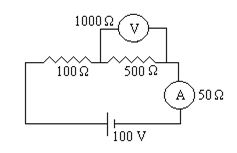
Ans : 0.206 Amp , 69.96 volt
8.
Find the current passing through the battery in the circuit

Ans : 1.56 amp
9.
In the circuit a voltmeter reads 30V when it is connected across 400ohm resistance. Calculate the reading of the same voltmeter when it is connected across 300 ohm resistance.

Ans : 22.5 volt
10.
A battery of 2 volt is connected across two points of a circular wire of resistance 10 ohm. Find the current passing through the battery in each case.
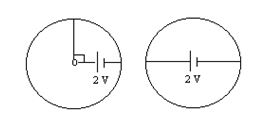
Ans : 16/15 amp , 0.8 amp
11.
A potential difference of 220 volt is maintained across a 12000 \displaystyle \Omega rheostat. The voltmeter `V’ has a resistance of 6000 \displaystyle \Omega and point C is at one-fourth of the distance from A to B. What is the reading of the voltmeter.
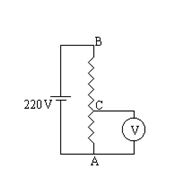
Ans: 40 volt
Q.12
In the circuit shown it is given that the potential difference between P and Q is 1volt. Calculate the value of the resistance R.
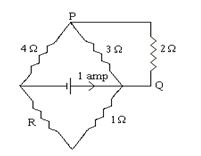
Ans : 25 \displaystyle \Omega
Q.13
Find the equivalent resistance of the following circuit. Also find the potential difference between the points will this change if 40W resistance is disconnected ?
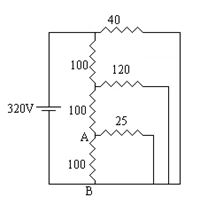
Ans : 20 volt
Q.14
Find the reading of the voltmeter and ammeter in the following circuit.
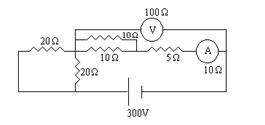
Ans : 187.5 volt , 9.3 amp
Q.15
N sources of currents with different emf are connected as shown.The emf of each source is proportional to their internal resistance r and is given by E = kr . Where a is a constant. Find the potential difference between A and B which divide the circuit between n and N-n sources and also find the current in the circuit.
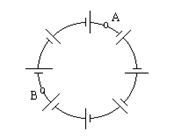
Ans : zero , k
Q.16
Find the current passing through the battery in the following circuit.
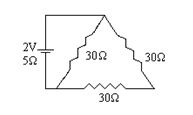
Ans : 0.08 amp
Q.17
You are given two resistors X and Y whose resistances are to be determined using an ammeter of resistance 0.5 \displaystyle \Omega and a voltmeter of resistance 20 k \displaystyle \Omega . It is known that X is in the range of a few ohms, while Y is in the range of several thousand ohms. In each case, which of the following two connections would you choose for resistance measurement?.
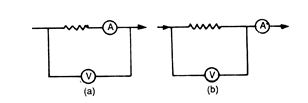
Q.18
A battery of e.m.f. 9 V and negligible internal resistance is connected to a 3 k \displaystyle \Omega resistor. The potential drop across a part of the resistor (between points A and B in the figure) is measured by (a) a 20 k \displaystyle \Omega voltmeter, (b) a 1 k \displaystyle \Omega voltmeter. In (c) both the voltmeters are connected across AB. In which case would you get the (1) highest, (2) lowest reading?


